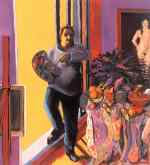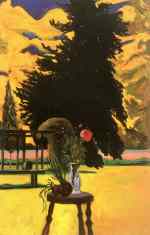Home
Paul Georges
by Robert Sievert
or the title
to see a larger view
of the picture.

Painting In The Studio

Dance of the Muses

Landscape With Still Life
Paul Georges had a direct link to the old masters. He also had a direct link to the action painters of the fifties. As a young man he studied with Hans Hoffmann. Hoffmann’s theoretical dissection of space and form, examination of the masters of painterly style (Rembrandt through Matisse), supposedly inspired Abstract Expressionism, but less celebrated are the painters who went on to take the same practice down the representational road.
Georges did not rely on theory. His paintings were always informed by spatial theory but not didactic. His handling of paint was intutitive, lavish and direct, as painterly as any abstract expressionst. This was a platform for the work which flowed out of him. He seemed to effortlessly create paintings he said were inspired by his muse, whom he often pictured as a robust young woman. All Georges' figures were exuberant. One of his last paintings was of the nine muses dancing through his studio. These images of women were earthy and humanistic... no obsession with anatomy... a direct and loving comment. Draughtsmansip created volume as well as line.
Strangely,while his health seemed to be in good shape, he painted this "MY POSTHUMOUS SERIES", which make up a good deal of the show. Here are endgame paintings that fit the discription of so many other final works of other artists at the end of their lives. Large dark masses taking over the space, none more prophetic than his ANGEL AT THE SKYLIGHT. In this picture the artist represents himself in a small figure at the bottom of a oppressive gray mass; above a black ceiling slices through the picture like a guillutine blade and within the black, through a skylight, an angel flies. Georges always called his beautiful women "muses" so one can only assume that he felt differently about this one,naming her "angel"....
All in all the subject matter of this show is relevant. This was not always the case with his work. Somehow this enormous talent was not always guided by sound intellectual thought. Georges struggled to make relevant art. In the seventies he painted the leaders of the civil rights movement. Subject matter presented difficuties, somehow he tried to equate subjects with the largeness he sensed in his own work.... He painted the big subjects of his time, space people, political figures, and yet the best was always his off hand still lifes, studio nudes, potraits of his family, informal pictures that allowed his talent to flow out of him. In this Posthumous series all the pictures are his final comments on the natural world of which he had such great mastery in representing.
PAINTING IN THE STUDIO 2001 is perhaps the grandest statement of the show. A self portrait, full figured, instantly recognizable to anyone who knew the artist or his work is now bathed in a golden yellow light flooding into the room. Next to him is a still life, that while painted in the fastest and loosest of manner, contains all the knowledge and discipline of the painterly tradition. the color and placement of form is rivaled only by the freshness and clarity of the paint. Adding another dimension,only after while is it apparent that the arm in the lower right corner is one of his muses who is more fully represented in a mirror in back of the still life, a composition that seems to have precedents in Velásquez.